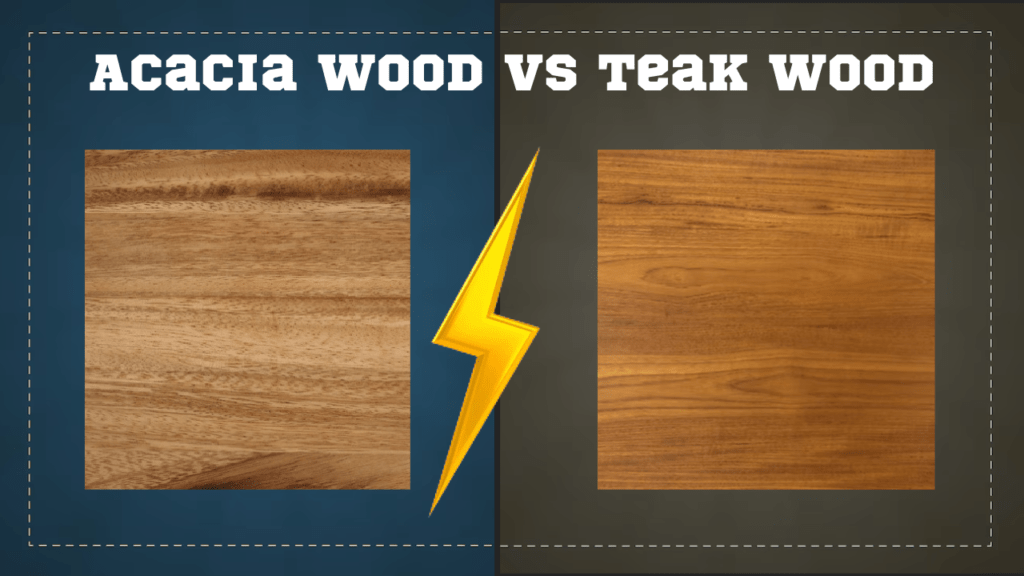
Acacia Wood vs Teak Wood – While designing your home, you have to consider a wide range of factors and one of the most important is choosing the perfect type of wood for your furniture which comes down to more than just aesthetic appeal – it also depends on durability, ease of maintenance and cost too among other things that determine its performance over time. Here is a selection of two highly sought after woods which you can consider: Acacia and Teak
Both of these hardwoods are long lasting materials and provide for timeless appearance. But which is better, indoor artistry or outdoor hardiness? Our detailed guide below will cover everything you need to know about Acacia vs Teak wood, it’s properties, pros and cons, pricing and best use cases so that you can make an educated choice.
What Is Acacia Wood ?
Acacia is a rapidly growing hard wood species that grows in tropical and warmer regions such as Africa, Asia and Australia. It is prized for:
- Golden to dark brown in warm hues
- Natural oils that resist water, scratches and pests
- Affordable and rapidly regrown, acacia has been utilized throughout history to make everything from ships to furniture and flooring.
Also read: Acacia Wood: Is It Truly Waterproof?
What Is Teak Wood?
Teak (found mostly in Tectona grandis trees in South and Southeast Asia) is commonly known as the “King of Hardwoods.” Its reputation comes from:
- Straight grain and smooth gold brown finish
- High oil and silica content, it is naturally resistant to water, decay, fungi and termites
- Age old maintenance free legendary durability that last decades with little maintenance
- Teak was long used in shipbuilding — its resistance to saltwater is exceptional — but today it is the gold standard for outdoor furniture and luxury interiors.
Acacia vs Teak: Head-to-Head Comparison
| Feature | Acacia Wood | Teak Wood |
| Appearance | Rustic, varied grain patterns; warm tones | Smooth, golden brown that ages to silvery grey |
| Durability | Strong and dense but needs sealing | Extremely durable; withstands decades outdoors |
| Water Resistance | Naturally resistant but not waterproof | Superior resistance due to high natural oils |
| Maintenance | Needs regular cleaning, oiling, and care | Low maintenance; simple cleaning is enough |
| Lifespan | 10–20 years with proper care | 50+ years, often becoming heirloom furniture |
| Price | Affordable to moderate | Premium, often 2–3x the cost of Acacia |
| Eco-friendliness | Fast-growing and sustainable | Plantation-grown teak is sustainable but rarer |
| Best Use | Indoor furniture, covered patios, décor | Outdoor furniture, decks, exposed environments |
Pros and Cons of Acacia
✅ Pros:
- Budget-friendly alternative to teak
- Different rustic charm and patterns
- Eco-friendly and renewable
- Naturally antimicrobial and scratch-resistant
❌ Cons:
- Sensitve to harsh sun and high humidty
- Requires sealing and maintenance to avoid cracking
- May warp or discolor if left outside without treatment
Pros and Cons of Teak
✅ Pros:
- Extremely durable and long-lasting
- Resistant to water, rot, pests, and UV rays
- Low maintenance, ages beautifully into silver-grey
- Perfect for outdoor and harsh climates
❌ Cons:
- Expensive and harder to source
- Heavy weight makes furniture less portable
- Untreated teak may lose golden color (though many love the patina)
Which is Better: Acacia or Teak?
There’s really no one answer that fits all; it depends on your budget, where you live and your particular design flavor:
Choose Acacia if you have been in the market for an inexpensive eco-friendly and rustic for indoor furniture or covered outdoor areas.
For durable, high endurance wood, choose Teak which can withstand the elements, even moisture, outdoors.
FAQ’s About Acacia vs Teak Wood
1. Is Acacia a good wood for outdoor furniture?
Yes you can use Acacia Outdoors, but it needs to be sealed and occasionally up kept to protect it from moisture, sun and heat. For best results, it can be used in the covered/ shaded areas.
2. What makes Teak the best wood for outdoor furniture?
The natural oils in teak make it equally resistant to water, rot, UV rays and insects—attributes that few other hardwoods can boast. That makes it the gold standard of outdoor furniture.
3. Which is cheaper: Acacia or Teak?
Acacia is the ideal option for budget-minded buyers. Teak, on the other hand, is an investment because it lasts.
4. Is Acacia as durable as Teak?
No. That special care also means your acacia will only last 10-20 years but teak can last 50+ years and can be handed down as heirloom furniture.
5. What is the ageing appearance of Teak / Acacia?
Acacia is rustic but can patina without treatment.
Teak weathers to a beautiful silver-grey some people find appealing.
Final Thoughts
In the battle of Acacia vs Teak wood, let’s find out the final verdict that wins it all (money vs strength):
Acacia – An elegant affordable eco-friendly composite that needs less love to own, less time to install and less skill to use compared to traditional fences.
Teak can’t be beat for its resilience, longevity, weather resistance and stunning clarity, and is well worth the splurge.
If your going to have outdoor furniture that’s exposed to the elements year-round Teak is king. But for interior charm that won’t break the bank or exterior beauty under a roof, Acacia provides fantastic value.

